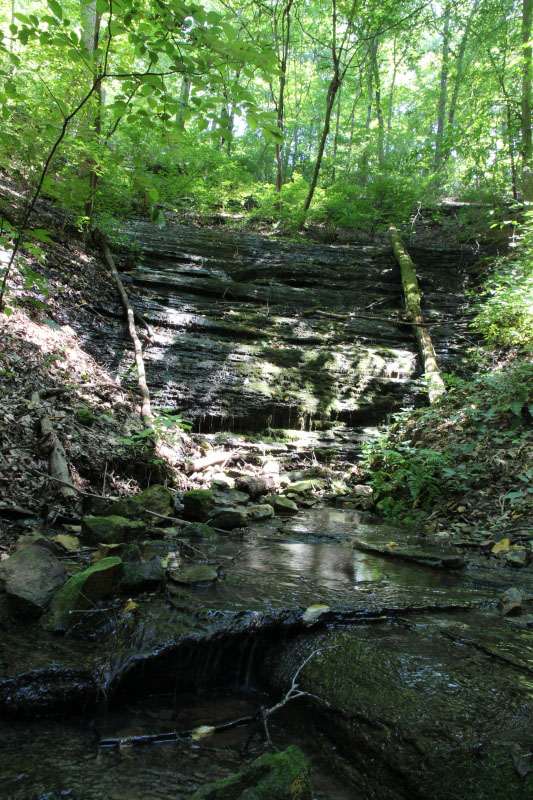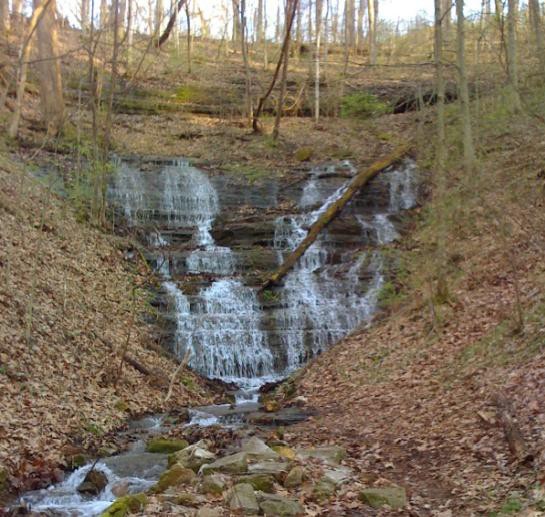
Featured ANIMALS
Box Turtles
Timber Rattlesnakes
Coyotes
Streamside Salamander
Featured PLANTS
Spring Ephemerals
Old Growth
Forest Composition
Essay on woods
Honeysuckle
LANDSCAPE
Historic Wall
Geology
Cave
Waterfall
Conservation
Ecological Corridor
Development Planning

|
Superb Nature Should be Public
The day I learned that the West Meade waterfall was for sale, waves of impassioned shivers rattled down my spine. This slice of nature is a prime example of land that should be owned by the public. The waterfall is sacred. For me, for the late great conservationist Bob Brown, and for many, many, more, the waterfall is our temple. We have flocked to this hallowed ground time and time again to find refuge and renewal. Wandering through nature can center you, can cleanse your soul, and can teach you about the true necessities of life. This waterfall is the location you come to find God. Sheets of clean water burst out of the hillside in a wide spring, cascading down layers of black shale. In the dry months, it is a mere trickle through the moss. After a major storm, it is a gushing white torrent. In the winter, icicle curtains close off small caves for children to peek their heads behind. Through it all, the water always runs clear. No matter what the season, a fresh breeze pours onto you as you approach. Ground-cooled water infuses the air with life. This is where colors come to be nourished. Standing in the tiny pool at the foot of the waterfall, you are standing in the concert hall of a well-tuned miniature orchestra of gurgles. The canopy of old oaks provides a cool, moist, shady habitat for many sensitive critters. Behind the waterfall, lie a couple hundred acres of mature forest that hold the last undeveloped long stream valley in the whole area. Entomologist Steve Hamilton took a brief look at some of the aquatic invertebrates beneath the waterfall, and found that the faunal diversity remains remarkably healthy. I can usually find red salamanders (Pseudotriton ruber) breeding here. Red salamanders are a sparsely distributed species dependent on unpolluted water and ample surrounding mature forest. This is the kind of place where we speculate about whether some of the hard-to-identify species actually occur only here and nowhere else. Miraculously, the waterfall and the woods behind it have survived 200 years in an expanding city. Of course, I yearn for the days before any roads approached. Oh, to be Bob Brown, wander up the small forested creek towards the head of a narrowing valley, come face to face with this elaborate towering beauty, and then kneel down to quench the thirst of a full days’ adventure. Yet, as much as I love vast expanses of wilderness, there is something to be said for superb nature that is a 30 second walk from a city road. It is open to everyone who wants to dip their toes in. The waterfall, as much as any place I can think of, belongs to everyone. It boggles my mind to think that such a place is private property. Should the spiritual fortunes of so many future generations of neighbors hinge on the whimsy of the next owner? The current owners, have been wonderful stewards of the land, and I know that they have invested a lot into their property. This is my heart pleading for owners of natural wonders such as West Meade’s waterfall to commit to selling or donating the property in one of the many ways that will ensure a lasting legacy. Take advantage of the tax incentives for establishing a conservation easement or for selling at a low price to a nonprofit. A previous owner planned to build a house on the waterfall. Luckily, those plans fell through, and the waterfall narrowly escaped. How many more owners until luck runs out? Now is an opportunity to permanently protect this space. The waterfall is sacred.
--Noah Charney
|


|
|
|